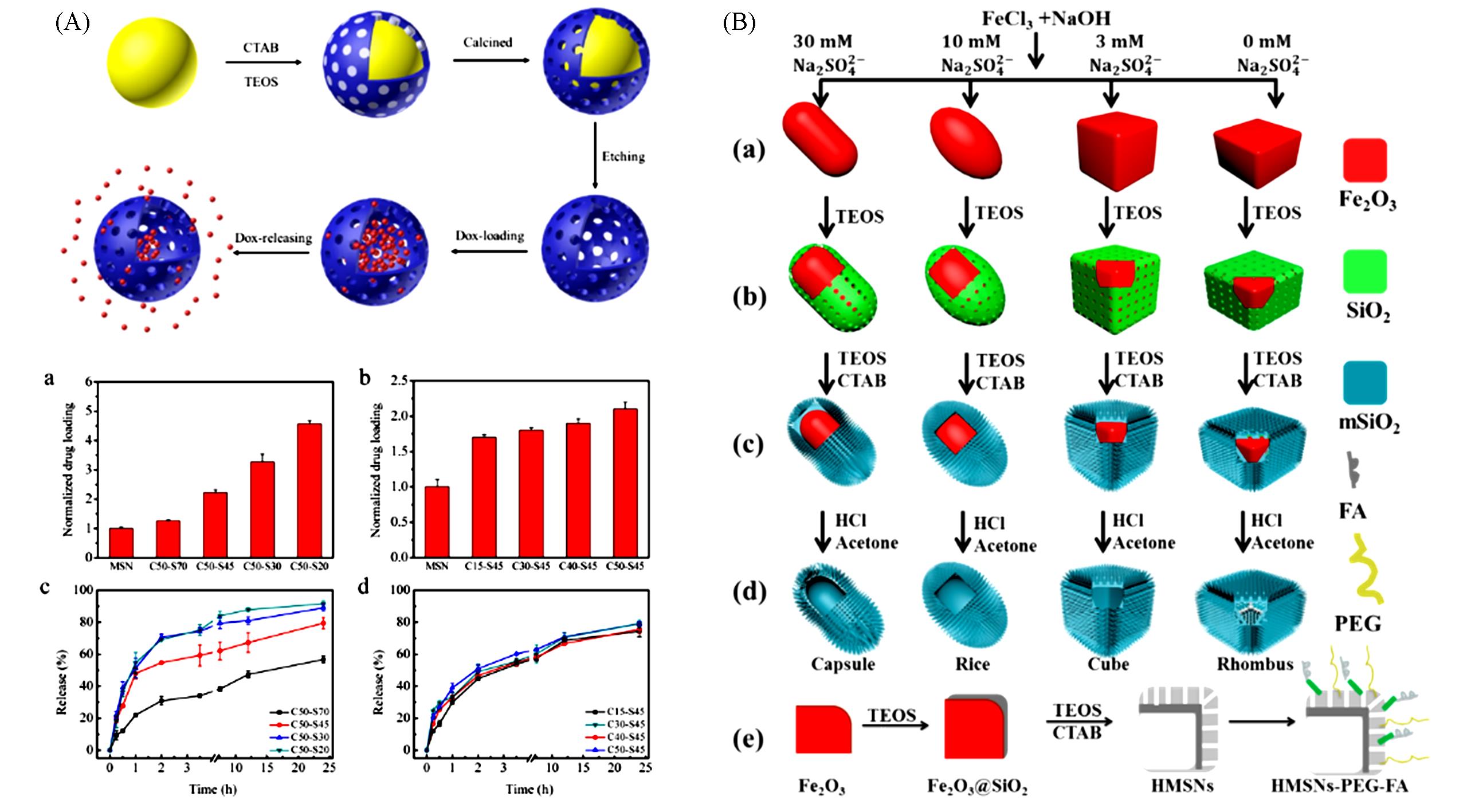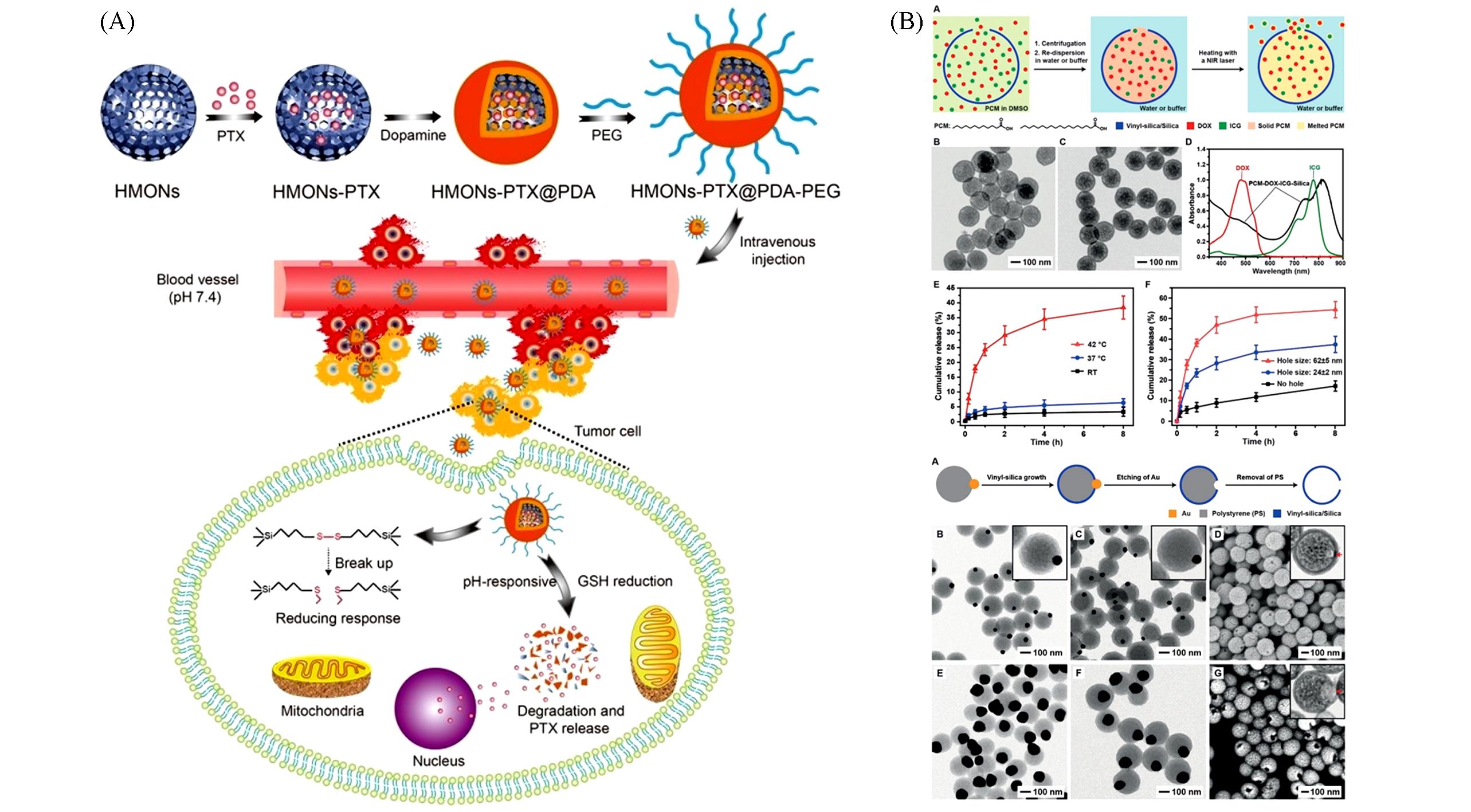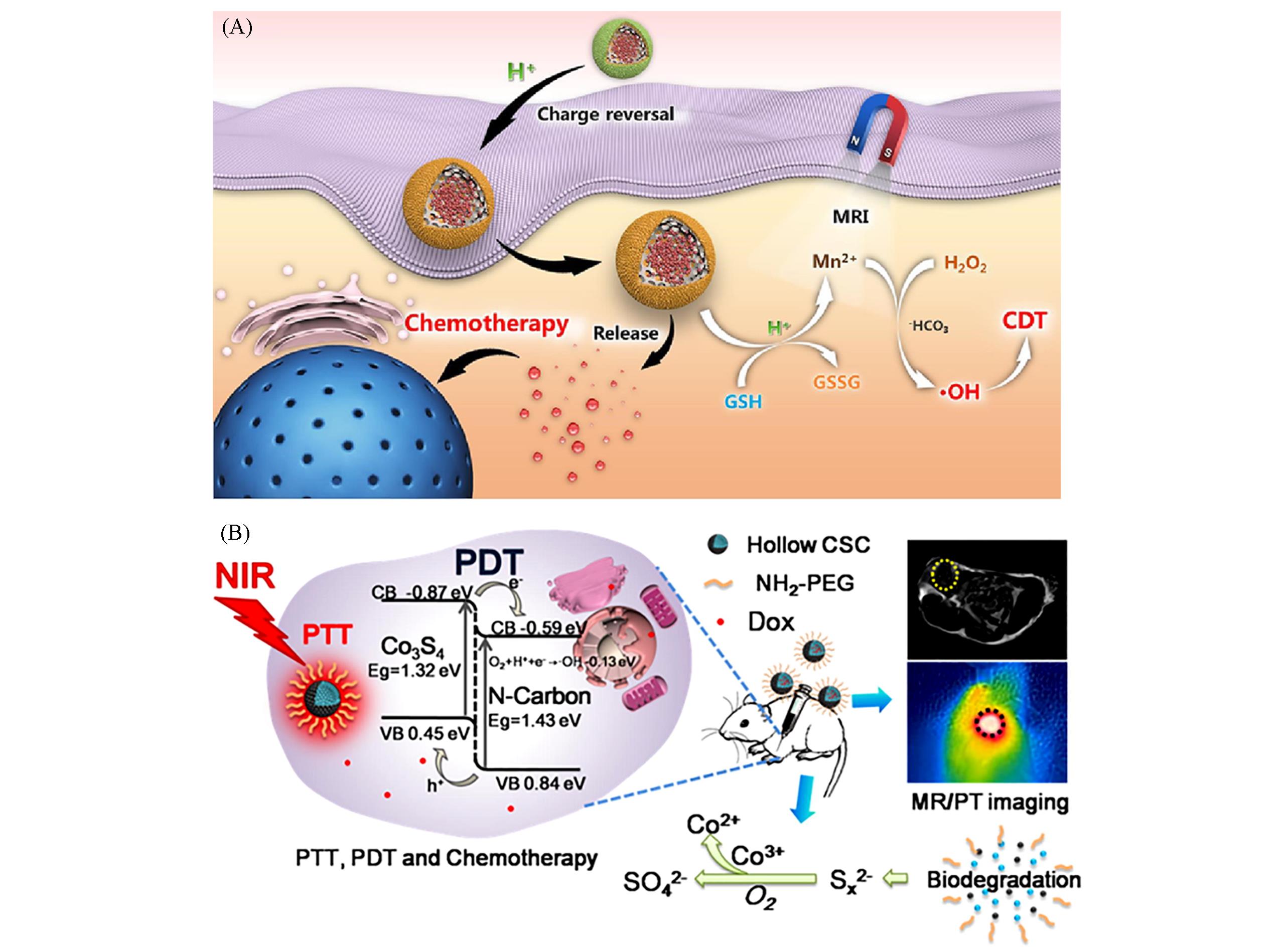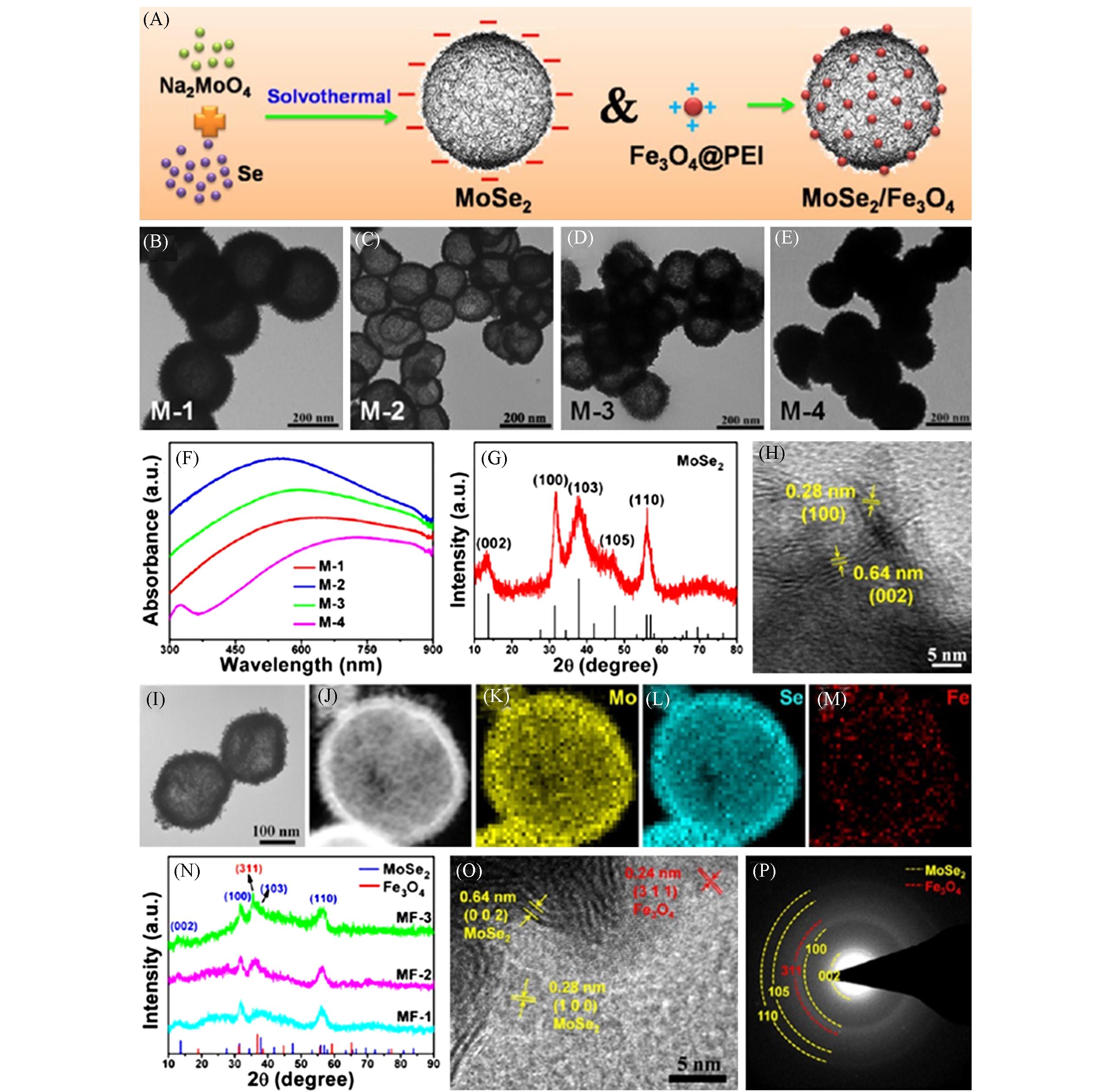

Chem. J. Chinese Universities ›› 2023, Vol. 44 ›› Issue (8): 20230134.doi: 10.7503/cjcu20230134
• Review • Previous Articles Next Articles
ZHANG Lu1, ZOU Yunhe2, XU Zhongsheng3( ), LIU Yun3(
), LIU Yun3( )
)
Received:2023-03-27
Online:2023-08-10
Published:2023-05-23
Contact:
XU Zhongsheng, LIU Yun
E-mail:zhongshengxu@cqmu.edu.cn;yunliu@cqmu.edu.cn
Supported by:CLC Number:
TrendMD:
ZHANG Lu, ZOU Yunhe, XU Zhongsheng, LIU Yun. Hollow-structured Nanomaterials for Biomedical Applications: Current Development and Future Prospective[J]. Chem. J. Chinese Universities, 2023, 44(8): 20230134.
Type of hollow⁃structured nanomaterials | Structural characteristic | Advantage |
|---|---|---|
| Hollow mesoporous silica nanoparticles | Hollow spheres with silicic shell | Adjustable sizes of cavity and pore, environmental friendliness and low cost |
| Hollow polymer particles | Hollow capsules with polymer shell | Effectively avoid the drug release and failure in the blood circulation |
| Hollow metal oxide nanospheres | Hollow spheres with metal oxide shell | Metal oxide intrinsic properties: superior magnetic properties or multiple enzymatic activities |
| Hollow metal-sulfide nanospheres | Hollow spheres of metal-sulfide shell | Metal-sulfide unique electronic, optical and catalytic properties |
| Hollow multiple shells nanospheres | Hollow spheres of multiple shells | Improve the amount of drug loading and provide a prolonged drug release |
| Exosome | Hollow vesicle with proteins and lipids shell | Well biodistribution, biocompatibility and low immunogenicity |
Table 1 Summary of hollow-structured nanomaterials with different characteristics
Type of hollow⁃structured nanomaterials | Structural characteristic | Advantage |
|---|---|---|
| Hollow mesoporous silica nanoparticles | Hollow spheres with silicic shell | Adjustable sizes of cavity and pore, environmental friendliness and low cost |
| Hollow polymer particles | Hollow capsules with polymer shell | Effectively avoid the drug release and failure in the blood circulation |
| Hollow metal oxide nanospheres | Hollow spheres with metal oxide shell | Metal oxide intrinsic properties: superior magnetic properties or multiple enzymatic activities |
| Hollow metal-sulfide nanospheres | Hollow spheres of metal-sulfide shell | Metal-sulfide unique electronic, optical and catalytic properties |
| Hollow multiple shells nanospheres | Hollow spheres of multiple shells | Improve the amount of drug loading and provide a prolonged drug release |
| Exosome | Hollow vesicle with proteins and lipids shell | Well biodistribution, biocompatibility and low immunogenicity |

Fig.1 Schematic illustration of the preparation of HMSNs for drug loading and release(A)[26] and preparation of surface⁃modified multifunctional platforms(B)[27](A) Copyright 2017, American Chemical Society; (B) Copyright 2017, Wiley-VCH.

Fig.2 Schematic illustrating the synthesis of PMPC for encapsulating n(EGFP) and n(OVA)(A)[32], the design of the pH⁃sensitive hollow microspheres P(MBAAm⁃co⁃MAA)(B)[33](A) Copyright 2015, Tsinghua University Press; (B) Copyright 2009, Elsevier.

Fig.5 Schematic showing the formation of HMONs⁃PTX@PDA⁃PEG for GSH and pH stimuli⁃responsive drug release(A)[64] and the design of f silica nanocapsules with a well⁃defined hole for laser irradiation stimuli⁃responsive the anticancer drug release(B)[65](A) Copyright 2020, Wiley; (B) Copyright 2019, Wiley-VCH.

Fig.6 Schematic representation of the design of DOX@HMDN⁃PEI⁃PLL for combined chemo⁃chemo⁃ dynamic dulamodal therapy(A)[73] and the preparation of CSC2@PEG⁃Dox for combination chemotherapy(PDT and PDT)(B)[74](A) Copyright 2021, Elsevier; (B) Copyright 2020, Elsevier.

Fig.7 Schematic illustration of the synthesis of hollow MoSe2/Fe3O4 nanospheres for combined DOX drug delivery and CT/MR imaging [78](A) Schematic representation of MoSe2 and MoSe2/Fe3O4 nanomaterials; (B—E) TEM images of M-1 to M-4, respectively; (F) UV-Vis spectra of the four samples; (G) XRD pattern of M-2; (H) highlighted HRTEM image of M-2; (I) TEM image of MF-2; (J—M) HAADF-STEM image of MF-2 and the corresponding STEM-EDX elemental mapping images for Mo, Se and Fe; (N) XRD patterns of sample MF-1, MF-2 and MF-3; (O) highlighted HRTEM of MF-2; (P) SAED image of MF-2.
| 1 | Kreyling W. G., Semmler⁃Behnke M., Chaudhry Q., Nano Today, 2010, 5(3), 165—168 |
| 2 | Zhang H., Adv. Mater., 2020, 32(3), 1806328 |
| 3 | Song G., Wang Q., Wang Y., Lv G., Li C., Zou R., Chen Z., Qin Z., Huo K., Hu R., Adv. Funct. Mater., 2013, 23(35), 4281—4292 |
| 4 | Arabi M., Ghaedi M., Ostovan A., ACS Sustainable Chem. Eng., 2017, 5(5), 3775—3785 |
| 5 | Kapil A., Aggarwal G., Harikumar S., J. Drug Delivery Sci. Technol., 2014, 4(5), 21—28 |
| 6 | Singh R., Sharma A., Saji J., Umapathi A., Kumar S., Daima H. K., Nano Convergence, 2022, 9(1), 21 |
| 7 | Lim J., Lee Y. Y., Choy Y. B., Park W., Park C. G., Biomed. Eng. Lett., 2021, 11, 197—210 |
| 8 | Li Y., Shi J., Adv. Mater., 2014, 26(20), 3176—3205 |
| 9 | Wei R., Xu Y., Xue M., J. Mater. Chem. B, 2021, 9(8), 1965—1979 |
| 10 | Li Z., Xu K., Qin L., Zhao D., Yang N., Wang D., Yang Y., Adv. Mater., 2022,2203890 |
| 11 | Li Z., Xu K., Qin L., Zhao D., Yang N., Wang D., Yang Y., Adv. Mater., 2023, 35(12), 2203890 |
| 12 | Zhao D., Yang N., Xu L., Du J., Yang Y., Wang D., Nano Res., 2022, 1—19 |
| 13 | Chen J. F., Ding H. M., Wang J. X., Shao L., Biomaterials, 2004, 25(4), 723—727 |
| 14 | Shin J., Anisur R. M., Ko M. K., Im G. H., Lee J. H., Lee I. S., Angew. Chem. Int. Ed., 2009, 48(2), 321—324 |
| 15 | Gupta S., Singh I., Sharma A. K., Kumar P., Front. Bioeng. Biotechnol., 2020, 8, 504 |
| 16 | Teng Z., Su X., Zheng Y., Zhang J., Liu Y., Wang S., Wu J., Chen G., Wang J., Zhao D., J. Am. Chem. Soc., 2015, 137(24), 7935—7944 |
| 17 | She X., Chen L., Li C., He C., He L., Kong L., J. Nanomater., 2015, 16(1), 108 |
| 18 | Shi X., Wang S. H., Swanson S. D., Ge S., Cao Z., Van Antwerp M. E., Landmark K. J., Baker Jr J. R., Adv. Mater., 2008, 20(9), 1671—1678 |
| 19 | Gao X., Wei M., Ma D., Yang X., Zhang Y., Zhou X., Li L., Deng Y., Yang W., Adv. Funct. Mater., 2021, 31(52), 2106700 |
| 20 | Cheng M., Yu Y., Huang W., Fang M., Chen Y., Wang C., Cai W., Zhang S., Wang W., Yan W., ACS Biomater. Sci. Eng., 2020, 6(9), 4985—4992 |
| 21 | Ning S., Dai X., Tang W., Guo Q., Lyu M., Zhu D., Zhang W., Qian H., Yao X., Wang X., Acta Biomater., 2022, 152, 562—574 |
| 22 | Li W., Liu J., Zhao D., Nat. Rev. Mater., 2016, 1(6), 1—17 |
| 23 | Chen Y., Chen H., Zeng D., Tian Y., Chen F., Feng J., Shi J., ACS Nano, 2010, 4(10), 6001—6013 |
| 24 | Huang R., Shen Y. W., Guan Y. Y., Jiang Y. X., Wu Y., Rahman K., Zhang L. J., Liu H. J., Luan X., Acta Biomater., 2020, 116, 1—15 |
| 25 | Shi S., Chen F., Cai W., Nanomedicine, 2013, 8(12), 2027—2039 |
| 26 | Li Y., Li N., Pan W., Yu Z., Yang L., Tang B., ACS Appl. Mater. Interfaces, 2017, 9(3), 2123—2129 |
| 27 | Geng H., Chen W., Xu Z. P., Qian G., An J., Zhang H., Chem⁃Eur J., 2017, 23(45), 10878—10885 |
| 28 | Itou N., Masukawa T., Ozaki I., Hattori M., Kasai K., Colloid Surface A, 1999, 153, 311—316 |
| 29 | Zhang C., Yang D., Zhang T., Qiu F., Dai Y., Xu J., Jing Z., J. Cleaner Prod., 2017, 148, 398—406 |
| 30 | Bentz K. C., Savin D. A., Polym. Chem., 2018, 9(16), 2059—2081 |
| 31 | Kamaly N., Yameen B., Wu J., Farokhzad O. C., Chem. Rev., 2016, 116(4), 2602—2663 |
| 32 | Liang S., Liu Y., Jin X., Liu G., Wen J., Zhang L., Li J., Yuan X., Chen I. S., Chen W., Nano Res., 2016, 9, 1022—1031 |
| 33 | Yang X., Chen L., Huang B., Bai F., Yang X., Polymer, 2009, 50(15), 3556—3563 |
| 34 | Ke C. J., Lin Y. J., Hu Y. C., Chiang W. L., Chen K. J., Yang W. C., Liu H. L., Fu C. C., Sung H. W., Biomaterials, 2012, 33(20), 5156—5165 |
| 35 | Zhang Q., Zhang K., Xu D., Yang G., Huang H., Nie F., Liu C., Yang S., Prog. Mater Sci., 2014, 60, 208—337 |
| 36 | Kannan K., Radhika D., Sadasivuni K. K., Reddy K. R., Raghu A. V., Science I., Adv. Colloid Interface Sci., 2020, 281, 102178 |
| 37 | Sun Y. G., Piao J. Y., Hu L. L., Bin D. S., Lin X. J., Duan S. Y., Cao A. M., Wan L. J., J. Am. Chem. Soc., 2018, 140(29), 9070—9073 |
| 38 | Figuerola A., Di Corato R., Manna L., Pellegrino T., Pharmacol. Res., 2010, 62(2), 126—143 |
| 39 | Hajipour P., Eslami A., Bahrami A., Hosseini⁃Abari A., Saber F. Y., Mohammadi R., Mehr M. Y., Ceram. Int., 2021, 47(23), 33875—33885 |
| 40 | Lin L. Y., Karakocak B. B., Kavadiya S., Soundappan T., Biswas P., Sensor Actuat B: Chem., 2018, 259, 745—752 |
| 41 | Wang H., Wang W., Liu L., Wang M., Li G., Li H., Li B., Yu S., Ma D., Xue W., ACS Appl. Mater. Interfaces, 2021, 13(48), 57009—57022 |
| 42 | Xing R., Bhirde A. A., Wang S., Sun X., Liu G., Hou Y., Chen X., Nano Res., 2013, 6, 1—9 |
| 43 | Yu X. Y., Yu L., Lou X. W., Adv. Energy Mater., 2016, 6(3), 1501333 |
| 44 | Park J. S., Yang S. Y., Lee J. K., Kang Y. C., J. Mater. Chem. A, 2022, 10(34), 17790—17800 |
| 45 | Zhou H., Lv Z., Liu H., Liang M., Liu B., Guo H., Electrochim. Acta, 2017, 250, 376—383 |
| 46 | Fu J., Bie C., Cheng B., Jiang C., Yu J., Engineering, ACS Sustainable Chem. Eng., 2018, 6(2), 2767—2779 |
| 47 | Nan Z. A., Wang Y., Chen Z. X., Yuan S. F., Tian Z. Q., Wang Q. M., Commun. Chem., 2018, 1(1), 99 |
| 48 | Ding H., Yong J., Zhang J., Chen B., Ding B., Wang X., Ceram. Int., 2022, 48(11), 16085—16090 |
| 49 | Ma X., Zhang X., Yang L., Wang G., Jiang K., Wu G., Cui W., Wei Z., Nanoscale, 2016, 8(16), 8687—8695 |
| 50 | Boopathy A. V., Mandal A., Kulp D. W., Menis S., Bennett N. R., Watkins H. C., Wang W., Martin J. T., Thai N. T., He Y., PNAS, 2019, 116(33), 16473—16478 |
| 51 | Qiu M., Wang D., Liang W., Liu L., Zhang Y., Chen X., Sang D. K., Xing C., Li Z., Dong B., PNAS, 2018, 115(3), 501—506 |
| 52 | Zhao D., Wei Y., Jin Q., Yang N., Yang Y., Wang D., Angew. Chem. Int. Ed., 2022, 61(36), e202206807 |
| 53 | Zhao D., Yang N., Wei Y., Jin Q., Wang Y., He H., Yang Y., Han B., Zhang S., Wang D., Nat. Commun., 2020, 11(1), 4450 |
| 54 | Wu L., Zhang H., Wu M., Zhong Y., Liu X., Jiao Z., Micropor. Mesopor. Mater., 2016, 228, 318—328 |
| 55 | Guo W., Chen Z., Chen J., Feng X., Yang Y., Huang H., Liang Y., Shen G., Liang Y., Peng C., J. Nanobiotechnol., 2020, 18, 1—18 |
| 56 | Wang J., Chen D., Ho E., J. Controlled Release, 2021, 329, 894—906 |
| 57 | Peng H., Ji W., Zhao R., Yang J., Lu Z., Li Y., Zhang X., J. Mater. Chem. B, 2020, 8(34), 7591—7608 |
| 58 | Dad H. A., Gu T., Zhu A., Huang L., Peng L., Mol. Ther., 2021, 29(1), 13—31 |
| 59 | Yuan A., Ruan L., Jia R., Wang X., Wu L., Cao J., Qi X., Wei Y., Shen S., ACS Appl. Nano Mater., 2021, 5(1), 996—1002 |
| 60 | Zhao T., Wang P., Li Q., Al‐Khalaf A. A., Hozzein W. N., Zhang F., Li X., Zhao D., Angew. Chem. Int. Ed., 2018, 57(10), 2611—2615 |
| 61 | Li X., Zhao W., Liu X., Chen K., Zhu S., Shi P., Chen Y., Shi J., Acta Biomater., 2016, 30, 378—387 |
| 62 | Zhang J., Lin Y., Lin Z., Wei Q., Qian J., Ruan R., Jiang X., Hou L., Song J., Ding J., Adv. Sci., 2022, 9(5), 2103444 |
| 63 | Ding C., Tong L., Feng J., Fu J., Molecules, 2016, 21(12), 1715 |
| 64 | Chen Q., Chen Y., Zhang W., Huang Q., Hu M., Peng D., Peng C., Wang L., Chen W., ChemMedChem, 2020, 15(20), 1940—1946 |
| 65 | Qiu J., Huo D., Xue J., Zhu G., Liu H., Xia Y., Angew. Chem. Int. Ed., 2019, 58(31), 10606—10611 |
| 66 | Xie J., Liu G., Eden H. S., Ai H., Chen X., Acc. Chem. Res., 2011, 44(10), 883—892 |
| 67 | Lee D. E., Koo H., Sun I. C., Ryu J. H., Kim K., Kwon I. C., Chem. Soc. Rev., 2012, 41(7), 2656—2672 |
| 68 | Guo Z., Chen M., Peng C., Mo S., Shi C., Fu G., Wen X., Zhuang R., Su X., Liu T., Biomaterials, 2018, 179, 134—143 |
| 69 | Biffi S., Voltan R., Rampazzo E., Prodi L., Zauli G., Secchiero P., Expert Opin. Drug Del., 2015, 12(12), 1837—1849 |
| 70 | Mieszawska A. J., Mulder W. J., Fayad Z. A., Cormode D. P., Mol. Pharmaceutics, 2013, 10(3), 831—847 |
| 71 | Ni G., Yang G., He Y., Li X., Du T., Xu L., Zhou S., Chem. Eng. J., 2020, 379, 122317 |
| 72 | Yang L., Hu B., Liu A. H., Zhang Y., Talanta, 2020, 215, 120893 |
| 73 | Xu X., Duan J., Liu Y., Kuang Y., Duan J., Liao T., Xu Z., Jiang B., Li C., Acta Biomater., 2021, 126, 445—462 |
| 74 | Lv K., Lin H., Qu F., Chem. Eng. J., 2020, 392, 124555 |
| 75 | Giardino A., Gupta S., Olson E., Sepulveda K., Lenchik L., Ivanidze J., Rakow⁃Penner R., Patel M. J., Subramaniam R. M., Ganeshan D., Acad. Radiol., 2017, 24(5), 639—649 |
| 76 | Yang X., Chen L., Han B., Yang X., Duan H., Polymer, 2010, 51(12), 2533—2539 |
| 77 | Liang S., Liao G., Zhu W., Zhang L., Biomater. Res., 2022, 26(1), 1—21 |
| 78 | Wang Y., Zhang F., Lin H., Qu F., ACS Appl. Mater. Interfaces, 2019, 11(47), 43964—43975 |
| 79 | Geng B., Xu S., Li P., Li X., Fang F., Pan D., Shen L., Small, 2022, 18(6), 2103528 |
| 80 | Liu T., Sun L., Zhang Y., Wang Y., Zheng J., J. Biochem. Mol. Toxicol., 2022, 36(1), e22942 |
| 81 | Di Rosanna P., Salvatore C., Curr. Pharm. Des., 2012, 18(26), 3889—3900 |
| 82 | Sho T., Xu J., Biotechnol. Appl. Biochem., 2019, 66(1), 4—13 |
| 83 | Tian Q., Xue F., Wang Y., Cheng Y., An L., Yang S., Chen X., Huang G., Nano Today, 2021, 39, 101162 |
| 84 | Liang Z., Liu W., Wang Z., Zheng P., Liu W., Zhao J., Zhong Y., Zhang Y., Lin J., Xue W., Acta Biomater., 2022, 143, 428—444 |
| 85 | Song G., Chao Y., Chen Y., Liang C., Yi X., Yang G., Yang K., Cheng L., Zhang Q., Liu Z., Adv. Funct. Mater., 2016, 26(45), 8243—8254 |
| 86 | Li X., Liu Y., Qi X., Xiao S., Xu Z., Yuan Z., Liu Q., Li H., Ma S., Liu T., Adv. Mater., 2022, 34(19), 2109004 |
| [1] | LI Ruisong, MIAO Zhengpei, LI Jing, TIAN Xinlong. Research Progress on Hollow Precious Metal-based Nanostructures for Oxygen Reduction Reaction [J]. Chem. J. Chinese Universities, 2023, 44(5): 20220730. |
| [2] | WU Yucai, DU Huan, ZHU Jiexin, XU Nuo, ZHOU Liang, MAI Liqiang. Intricate Hollow Structured Materials: Synthesis and Energy Applications [J]. Chem. J. Chinese Universities, 2023, 44(1): 20220689. |
| [3] | LIU Shuanghong, XIA Siyu, LIU Shiqi, LI Min, SUN Jiajie, ZHONG Yong, ZHANG Feng, BAI Feng. Current Advances of Hollow All-solid-state Z-Scheme Photocatalysts [J]. Chem. J. Chinese Universities, 2023, 44(1): 20220512. |
| [4] | WANG Sijia, HOU Lu, LI Chenglong, LI Wencui, LU Anhui. Recent Advances in Synthesis and Applications of Hollow Nano-carbons [J]. Chem. J. Chinese Universities, 2023, 44(1): 20220637. |
| [5] | YANG Qingfeng, LYU Liang, LAI Xiaoyong. Progress on Preparation and Electrocatalytic Application of Hollow MOFs [J]. Chem. J. Chinese Universities, 2023, 44(1): 20220666. |
| [6] | SHEN Xinyi, ZHANG Sen, WANG Shutao, SONG Yongyang. Synthesis Strategies for Polymer Hollow Particles [J]. Chem. J. Chinese Universities, 2023, 44(1): 20220627. |
| [7] | WANG Hui, ZHAO Decai, YANG Nailiang, WANG Dan. Gate Keeper in the Smart Hollow Drug Carrier [J]. Chem. J. Chinese Universities, 2023, 44(1): 20220237. |
| [8] | ZHU Kerun, REN Wenxuan, ZHANG Wei, LI Wei. Salt-templated Synthesis and Morphological Control of Monodisperse Hollow Mesoporous Structures [J]. Chem. J. Chinese Universities, 2023, 44(1): 20220607. |
| [9] | YANG Ruiqi, YU Xin, LIU Hong. Scientific Study of Photocatalytic Material Based on Sn3O4 [J]. Chem. J. Chinese Universities, 2021, 42(5): 1340. |
| [10] | WANG Changyao, WANG Shuai, DUAN Linlin, ZHU Xiaohang, ZHANG Xingmiao, LI Wei. In situ Confinement Growth Strategy for Ordered Mesoporous Carbon Support Ultrasmall MoO3 Nanoparticles [J]. Chem. J. Chinese Universities, 2021, 42(5): 1589. |
| [11] | GE Haoying, DU Jianjun, LONG Saran, SUN Wen, FAN Jiangli, PENG Xiaojun. Surface Functionalized Gold Nanomaterials in Tumor Diagnosis and Treatment [J]. Chem. J. Chinese Universities, 2021, 42(4): 1202. |
| [12] | SHI Jiangwei, MENG Nannan, GUO Yamei, YU Yifu, ZHANG Bin. Recent Advances of Two-dimensional Materials for Electrocatalytic Hydrogen Evolution [J]. Chem. J. Chinese Universities, 2021, 42(2): 492. |
| [13] | ZHANG Meng, WANG Shaosen, XIN Yuhao, LIU Xue, WU Qiuhua, ZHANG Guolin. Preparation and Drug Delivery Properties of Thermo/pH Dual Responsive Copolymer Composite Micelles of MPEG-b-PCL/PNVCL-b-PCL [J]. Chem. J. Chinese Universities, 2020, 41(12): 2822. |
| [14] | XU Kai,LI Yi,ZHAO Nan,DU Wenxiu,ZENG Weiwei,GAO Shuai,CHENG Xiaonong,YANG Juan. Synthesis of Hollow PtNi/Graphene Cellular Monolith Catalysts and Their Electrochemical Performance† [J]. Chem. J. Chinese Universities, 2016, 37(8): 1476. |
| [15] | GUAN Qingxiang, ZHANG Guangyuan, SUN Dandan, SUN Shilin, SUN Cheng, LIU Xin, HAN Bing. Investigation on Synthesis of Bletilla Striata Polysaccharides Amphiphilic Polymer and Drug-loaded Delivery System† [J]. Chem. J. Chinese Universities, 2016, 37(10): 1915. |
| Viewed | ||||||
|
Full text |
|
|||||
|
Abstract |
|
|||||